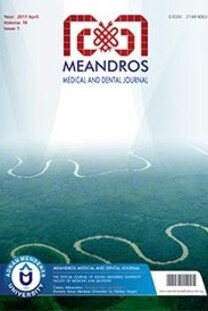Farklı İskeletsel Maloklüzyon Tiplerinde Orbit Vektör İlişkisinin Değerlendirilmesi
Evaluation of Orbit Vector Relationships in Different Types of Skeletal Malocclusions
___
- 1. Kale B, Buyukcavus MH, Esenlik E. Comparison of the change in inferior sclera exposure after maxillary protraction with or without skeletal anchorage. Niger J Clin Pract 2018; 21: 854-8.
- 2. Mommaerts MY. Definitive treatment of the negative vector orbit. J Craniomaxillofacial Surg 2018; 46: 1065-8.
- 3. Frey ST. New diagnostic tenet of the esthetic midface for clinical assessment of anterior malar projection. Angle Orthod 2013; 83: 790-4.
- 4. Sanadhya S, Chadha M, Chaturvedi MK, Chaudhary M, Lerra S, Meena MK, et al. Prevalence of malocclusion and orthodontic treatment needs among 12–15-year-old schoolchildren of fishermen of Kutch coast, Gujarat, India. Int Marit Health 2014; 65: 106-13.
- 5. Hassan R, Rahimah AK. Occlusion, malocclusion and method of measurements-an overview. Archives of Orofacial Sciences 2007; 2: 3-9.
- 6. Riedel RA. The relation of maxillary structures to cranium in malocclusion and in normal occlusion. Angle Orthod 1952; 22: 142-5.
- 7. Proffit WR. Contemporary orthodontics. 5th ed. Elsevier-Mosby; 2013.
- 8. Litt RA, Nielsen IL. Class II, division 2 malocclusion. To extract--or not extract? Angle Orthod 1984; 54: 123-38.
- 9. Gospe SM 3rd, Bhatti MT. Orbital Anatomy. Int Ophthalmol Clin 2018; 58: 5-23.
- 10. Zide B, Grayson B, McCarthy JG. Cephalometric analysis: part I. Plast Reconstr Surg 1981; 68: 816-23.
- 11. Brownlee RE. Anthropometry of the head and neck, 2nd ed. In: Leslie G. Farkas, editors. New York: Raven Press, 1994.
- 12. Tepper OM, Steinbrech D, Howell MH, Jelks EB, Jelks GW. A retrospective review of patients undergoing lateral canthoplasty techniques to manage existing or potential lower eyelid malposition: identification of seven key preoperative findings. Plast Reconstr Surg 2015; 136: 40-9.
- 13. Ngan P, Moon W. Evolution of Class III treatment in orthodontics. Am J Orthod Dentofacial Orthop 2015; 148: 22-36.
- 14. Doddamani GM, Swathi P V, Tan KFH. Assessment of anterior malar projection using visual photographs and lateral cephalograms: A comparative study. J Orthod Sci 2018; 7: 15.
- 15. Rajabi MT, Gholipour F, Ramezani K, Hosseini SS, Rajabi MB, Tabatabaie SZ. The influence of orbital vector on involutional entropion and ectropion. Orbit 2018; 37: 53-8.
- 16. Choi SY, Lee H, Baek S. Role of negative orbit vector in orbital blow-out fractures. J Craniofac Surg 2017; 28: 1925-8.
- ISSN: 2149-9063
- Yayın Aralığı: 4
- Başlangıç: 2000
- Yayıncı: Aydın Adnan Menderes Üniversitesi
Farklı İskeletsel Maloklüzyon Tiplerinde Orbit Vektör İlişkisinin Değerlendirilmesi
Mehmet Özveren, Pamir Meriç, Neslihan Özveren, Rüveyde Garip
Mehmet Taşpınar, Bülend İnanç, Ahu Dikilitaş
Apelin 13’ün Deneysel Ülseratif Kolit Üzerindeki Etkilerinin Araştırılması
Ferhat Şirinyıldız, Gökhan Cesur
Labial Adhesion in Adulthood: A Report of Two Cases
Mert Küçük, Selda Demircan Sezer, Sümeyra Nergiz Avcıoğlu, Sündüz Özlem Altınkaya, Hasan Yüksel, Emre Zafer
Merve Çakır, Serpil Çokakoğlu, Alp İlgenli
Işıl Karaokutan, Sezgi Cinel Şahin, Hatice Lamia Elif Sagesen
Koronavirüs Hastalığında Hastalık Şiddeti ve Enflamasyonla İlgili Göstergeler Arasındaki İlişki
Adem Keskin, Recai Aci, Utku Duran, Melek Bilgin, Göksenin Ünlügüzel Üstün, Mukadder Erdem
Youtube Rejeneratif Endodonti için Nitelikli Bir Bilgi Kaynağı mı?
